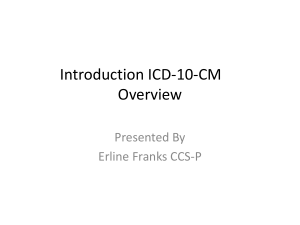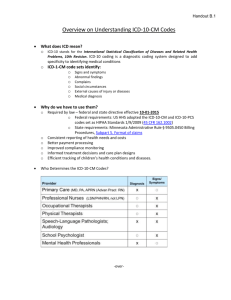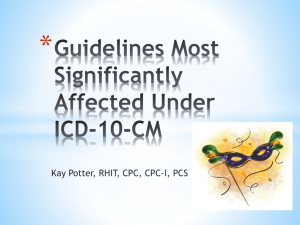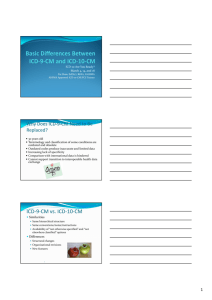Basic Introduction to ICD-10-CM
advertisement
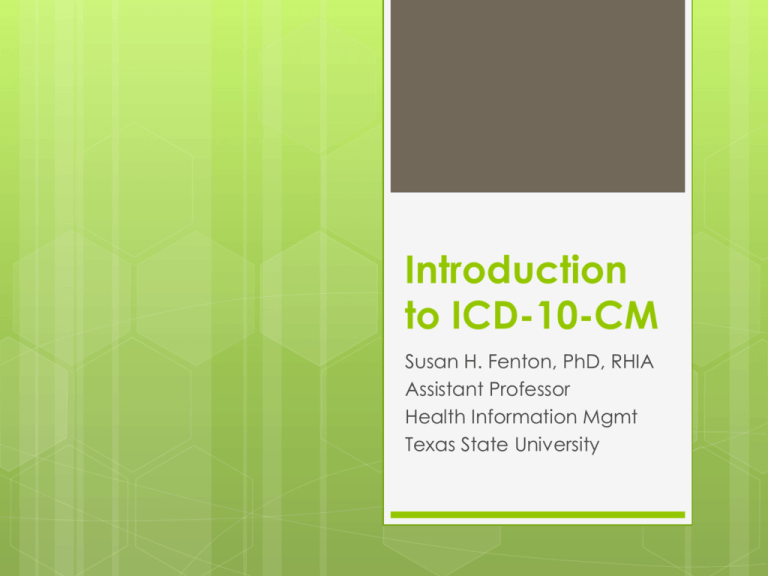
Introduction to ICD-10-CM Susan H. Fenton, PhD, RHIA Assistant Professor Health Information Mgmt Texas State University ICD-10 Final RuleCMS-0013-F •Published January 16, 2009 •October 1, 2013 –Compliance date for implementation of ICD-10-Clinical Modification (CM) and ICD-10-Procedure Coding System (PCS) http://edocket.access.gpo.gov/2009/pdf/ E9-743.pdf3 ICD-10 Implementation •Single implementation date for all users –Date of service for ambulatory and physician reporting –Date of discharge for inpatient settings •ICD-9-CM codes will not be accepted for services provided on or after October 1, 2013 •ICD-9-CM claims for services prior to implementation date will continue to flow through systems for a period of time •No grace period Benefits of ICD-10-CM Up-to-date classification systems will provide much better data for: –Measuring the quality, safety, and efficacy of care –Designing payment systems and processing claims for reimbursement –Conducting research, epidemiological studies, and clinical trials –Setting health policy –Operational and strategic planning and designing healthcare delivery systems –Monitoring resource utilization –Improving clinical, financial, and administrative performance –Preventing and detecting healthcare fraud and abuse –Tracking public health and risks ICD-10-CM Structure ICD-9-CM 3 -5 characters First character is numeric or alpha (E or V) Characters 2-5 are numeric Always at least 3 characters Use of decimal after 3 characters ICD-10-CM 3 -7 characters Character 1 is alpha (all letters except U are used) Character 2 is numeric Characters 3 -7 are alpha or numeric Use of decimal after 3 characters Use of dummy placeholder “x” Alpha characters are not case-sensitive ICD-9-CM Structure –Format 3 -5 Characters 496 414.00 V55.3 Codes longer than 3 characters always have decimal point after first 3 characters 1st character: alpha or numeric 2nd through 5th characters: numeric ICD-10-CM Structure – Format 3 -7 Characters P09 S32.010A O9A.211 M1A.0111 Codes longer than 3 characters always have decimal point after first 3 characters 1st character: alpha 2nd through 7th characters: alpha or numeric 7th character used in certain chapters (obstetrics, musculoskeletal, injuries, and external causes of injury) ICD-10-CM: Similarities to ICD-9-CM Tabular • List and Index Format Chapters in Tabular structured similarly to ICD-9-CM, with minor exceptions –A few chapters have been restructured –Sense organs (eye and ear) separated from Nervous System chapter and moved to their own chapters • Index structured the same as ICD-9-CM –Alphabetic Index of Diseases and Injuries –Alphabetic Index of External Causes –Table of Neoplasms –Table of Drugs and Chemicals ICD-10-CM: Similarities to ICD-9-CM Divided into Alphabetic Index and Tabular List • • • • Structure and format are the same Index is alphabetical list of terms and their corresponding codes Alphabetic Index lists main terms in alphabetical order with indented subterms under main terms Index is divided into 2 parts: Index to Diseases and Injuries and Index to External Causes ICD-10-CM: Similarities to ICD-9-CM Tabular List is a chronological list of codes divided into chapters based on body system or condition Tabular List is presented in code number order Same hierarchical structure Codes are invalid if they are missing an applicable character Codes are looked up the same way –Look up diagnostic terms in Alphabetic Index –Then verify code number in Tabular List ICD-10-CM: Similarities to ICD-9-CM Many conventions have same meaning –Abbreviations, punctuation, symbols, notes such as “code first” and “use additional code” Nonspecific codes (“unspecified” or “not otherwise specified”) are available to use when detailed documentation to support more specific code is not available ICD-10-CM: Similarities to ICD-9-CM ICD-10-CM Official Guidelines for Coding and Reporting accompany and complement ICD-10-CM conventions and instructions Adherence to the official coding guidelines in all healthcare settings is required under the Health Insurance Portability and Accountability Act ICD-10-CM: Differences from ICD-9-CM All codes are alphanumeric –1st character is always alpha and alpha characters may appear elsewhere in the code as well Codes can be up to 7 characters in length Codes are more specific Code titles are more complete (no need to refer back to a category, subcategory, or subclassification level to determine complete meaning of code) ICD-10-CM: Differences from ICD-9-CM Laterality (side of the body affected) has been added to relevant codes Expanded use of combination codes –Certain conditions and associated common symptoms or manifestations –Poisonings and associated external cause Injuries grouped by anatomical site rather than type of injury Codes reflect modern medicine and updated medical terminology Combination Codes – Examples I25.110 Atherosclerotic heart disease of native coronary artery with unstable angina pectoris E11.311 Type 2 diabetes mellitus with unspecified diabetic retinopathy with macular edema K71.51 Toxic liver disease with chronic active hepatitis with ascites K50.012 Crohn’s disease of small intestine with intestinal obstruction N41.01 Acute prostatitis with hematuria ICD-10-CM Injury Changes ICD-9-CM –Fractures (800-829) –Dislocations (830-839) –Sprains and strains(840-848) ICD-10-CM –Injuries to the head (S00-S09) –Injuries to the neck (S10-S19) –Injuries to the thorax (S20-S29) ICD-10-CM: Differences from ICD-9-CM Addition of 7th character Used in certain chapters to provide information about the characteristic of the encounter Must always be used in the 7th character position If a code has an applicable 7th character, the code must be reported with an appropriate 7th character value in order to be valid ICD-10-CM 7th Character Injuries –& External Causes A Initial encounter D Subsequent encounter S Sequela Note: For aftercare of an injury, assign acute injury code with 7th character “D” ICD-10-CM 7th Character – Fractures A Initial encounter for closed fracture B Initial encounter for open fracture D Subsequent encounter for fracture with routine healing G Subsequent encounter for fracture with delayed healing K Subsequent encounter for fracture with nonunion P Subsequent encounter for fracture with malunion S Sequela ICD-10-CM: Placeholder “X” Addition of dummy placeholder “X” is used in certain codes to: –Allow for future expansion –Fill out empty characters when a code contains fewer than 6 characters and a 7th character applies When placeholder character applies, it must be used in order for the code to be considered valid ICD-10-CM: Excludes Notes Excludes1 note –Indicates that code identified in the note and code where the note appears cannot be reported together because the 2 conditions cannot occur together Example: E10 Type 1 Diabetes mellitus Excludes1: diabetes mellitus due to underlying condition (E08.-) drug or chemical induced diabetes mellitus (E09.-) gestational diabetes (O24.4-) hyperglycemia NOS (R73.9) neonatal diabetes mellitus (P70.2) type 2 diabetes mellitus (E11.-) ICD-10-CM: Excludes Notes Excludes1 note –Additional example: M21 Other acquired deformities of limbs Excludes1: acquired absence of limb (Z89.-) congenital absence of limbs (Q71-Q73) ICD-10-CM: Excludes Notes Excludes2 note –Indicates that condition identified in the note is not part of the condition represented by the code where the note appears, so both codes may be reported together if the patient has both conditions Example: L89 Pressure ulcer Excludes2: diabetic ulcers (E08.621, E08.622, E09.621, E09.622, E10.621, E10.622, E11.621, E11.622, E13.621, E13.622) non-pressure chronic ulcer of skin (L97.-) skin infections (L00-L08) varicose ulcer (I83.0, I83.2) ICD-10-CM: Excludes Notes Excludes2 note –Additional example: I70.2 Atherosclerosis of native arteries of the extremities Excludes2: atherosclerosis of bypass graft of extremities (I70.30-I70.79) ICD-10-CM Specificity Examples S72.044G Nondisplaced fracture of base of neck of right femur, subsequent encounter for closed fracture with delayed healing I69.351 Sequelae of cerebral infarction, Hemiplegia and hemiparesis following cerebral infarction affecting right dominant side Z47.81 Encounter for orthopedic aftercare following surgical amputation Z48.21 Encounter for aftercare following heart transplant ICD-10-CM Laterality Examples C50.511 Malignant neoplasm of lowerouter quadrant of right female breast C50.512 Malignant neoplasm of lowerouter quadrant of left female breast C50.519 Malignant neoplasm of lowerouter quadrant of unspecified female breast ICD-9-CM Coding Example ICD-10-CM Coding Example Type 2 diabetes mellitus with diabetic nephropathy: 250.40 – Diabetes with renal manifestations, type II or unspecified, not stated as uncontrolled AND 583.81 – Nephritis and nephropathy, not specified as acute or chronic, in diseases classified elsewhere Type 2 diabetes mellitus with diabetic nephropathy Step 1 Look up term in Alphabetic Index: Diabetes, diabetic (mellitus) (sugar) E11.9 type 2 E11.9 with nephropathy E11.21 ICD-10-CM Coding Example Type 2 diabetes mellitus with diabetic nephropathy (con’t) Step 2 Verify code in Tabular: E11 Type 2 diabetes mellitus E11.2 Type 2 diabetes mellitus with kidney complications E11.21 Type 2 diabetes mellitus with diabetic nephropathy Type 2 diabetes mellitus with intercapillary glomerulosclerosis Type 2 diabetes mellitus with intracapillary glomerulonephrosis Type 2 diabetes mellitus with Kimmelstiel- ICD-9-CM Coding Example ICD-10-CM Coding Example Malignant Neoplasm of Female Breast: 174.0 – 174.9 (no laterality) Malignant Neoplasm of Male Breast: 175.0 or 175.9 (no laterality) Breast Cancer Step 1 Look up term in Alphabetic Index: Neoplasm Table Breast, female, areola – C50.01- ICD-10-CM Coding Examples Malignant neoplasm of nipple and areola, right female breast (con’t) Step 2 Verify code in Tabular: C50.0 – Malignant neoplasm of nipple and areola C50.01 – Malignant neoplasm nipple and areola, female breast C50.011 – Malignant neoplasm of nipple and areola, right female breast C50.021 – Malignant neoplasm of nipple and areola, right male breast Through C50.929 – Malignant neoplasm of breast of unspecified site of unspecified male breast CMS Resources CMS Resources MS-DRG Conversion Report http://www.cms.hhs.gov/ICD10/Downloads /MsdrgConversion.pdf ICD-10 General Information http://www.cms.hhs.gov/ICD10 Additional Resources The following organizations offer providers and others ICD-10 resources AHIMA (American Health Information Management Association) http://www.ahima.org/icd10/default.aspx WEDI (Workgroup for Electronic Data Interchange) http://www.wedi.org HIMSS (Health Information and Management Systems Society) http://www.himss.org/icd10 Questions?? Thank you for your time and attention! Susan H. Fenton, PhD, RHIA susan.fenton@txstate.edu
